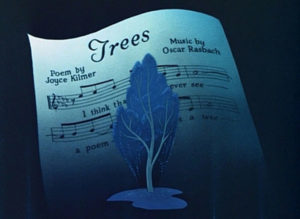
As Springtime got itself established in the year 1948, the staff in the music department at the Walt Disney Studios was hoping for good things. The new “package” feature was due for release around the end of May. And so, this is the first of several posts I’ll do examining the songs used in Disney’s Melody Time (1948).
 Now, the previous “package” picture, Fun And Fancy Free, had been released some eight months earlier. While the songs were pleasant enough, and some of them were covered widely–they didn’t exactly burn up the charts.
Now, the previous “package” picture, Fun And Fancy Free, had been released some eight months earlier. While the songs were pleasant enough, and some of them were covered widely–they didn’t exactly burn up the charts.
As it happened, Melody Time would be more akin to Make Mine Music, including several segments which could, if need be, be reissued separately at a later date. These segments would feature musical contributions by some big names from stage, screen, radio and/or records.
And, as with Make Mine Music, there were a couple of segments that did not feature songs that Disney’s people owned. These were older, still well-known songs–or specialty numbers.
Joyce Kilmer had written a short, simple, pastoral poem around 1913. Some nine years later, it was set to music by one Oscar Rasbach. The piece was published as an “art song”, and it was hoped that concert singers would pick it up. One wonders if there was any surprise on the part of the publishers when dance bands on the West Coast began playing the number as a fox-trot with vocal refrain.
Earl Burtnett and his Los Angeles Biltmore Hotel Orchestra were the first to record it in this form. Columbia 1190-D sold fairly well on the West Coast.
Somebody at competing Victor Records must have noticed the sales of the Columbia platter. A few months after Burtnett cut his version, a San Francisco-based band–that of Eddie Harkness, late of the Mark Hopkins Hotel, took the ferry across the Bay to visit Victor’s temporary studio in Oakland (where there was already a pressing-plant), and covered “Trees” for the Victor (21313). This, too, sold moderately well.
The real impetus for sales came in the spring of 1930, when Isham Jones orchestra cut a fox-trot version of “Trees”, featuring a vocal refrain by Frank Sylvano, a singer who could handle the extreme range of the piece. This Brunswick record (4856) sold extremely well. (It didn’t hurt that the other side of the disc was the first extremely good-selling version of Hoagy Carmichael’s famous “Stardust”.)
Within the next couple of years, Columbia and Victor covered “Trees” with New York-based studio dance bands. Victor went farther, and had John Charles Thomas–a concert baritone who had come out of Broadway shows to establish himself in his chosen field–to cut a “Red Seal” version of the song, accompanied by a soft concert orchestra.
Here is a swing version by Bunny Berigan from 1937:
So, “Trees” was already a well-known standard by the time Melody Time was being planned. Thus, it makes perfect sense that Fred Waring and his Pennsylvanians would pick up on it. Waring’s band went from collegiate jazz band, through being one of the premiere stage bands of the 1920’s (as can be seen in at least one Vitaphone short), to being America’s best-known glee club (providing its own orchestra accompaniment,to boot!) At the time, Waring’s aggregation was signed to Decca records.
And he did cut a version of “Trees” for Decca, which was duly issued. It’s also likely that Waring featured the song on radio broadcasts, as he was popular on the air at the time.
Later, Waring would get into television, and have some degree of success thee as he headed toward retirement-age.
But he saved his money well–and invested some of it (and lent his name to) an early food-processor for the home kitchen–the Waring Blendor!
NEXT WEEK: “Bumble Boogie”


 James Parten has overcome a congenital visual disability to be acknowledged as an expert on the early history of recorded sound. He has a Broadcasting Certificate (Radio Option) from Los Angeles Valley College, class of 1999. He has also been a fan of animated cartoons since childhood.
James Parten has overcome a congenital visual disability to be acknowledged as an expert on the early history of recorded sound. He has a Broadcasting Certificate (Radio Option) from Los Angeles Valley College, class of 1999. He has also been a fan of animated cartoons since childhood.












































“An Adventure in Art,” one of the early black-and-white episodes of the Disneyland TV series, features a segment in which four Disney artists are shown drawing their own interpretations of one tree.This provides an in-depth look at each artist’s creative vision concerning his version of the tree. As in other installments of the series, this recreates an earlier moment in the studio’s animation history. If I’m remembering correctly, the program concludes with the animated “Trees” segment from “Melody Time.”
This piece about the artists was later released as a short subject on its own.
“Trees” was also performed by Alfalfa in an Our Gang short.
Blendor?
It was originally called the “Miracle Mixer.” Fred Waring changed its name to the “Waring Blendor,” spelled with an “o.” (Wikipedia)
“Trees” is also featured in the 1934 Happy Harmonies cartoon, Toyland Broadcast.
And Bosko in an early Looney Tune (“Ain’t Nature Grand” I think) dances to it through the woods.
Bunny Berigan’s “Trees” is one of my all-time favorite single records from the Swing Era.